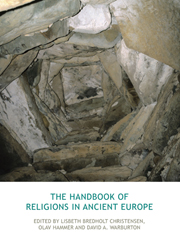Book contents
- Frontmatter
- Contents
- A note on Greek and Latin sources
- Abbreviations and short titles
- 1 Introduction
- PART I PREHISTORIC RELIGIONS
- PART II ANCIENT EUROPE IN THE HISTORICAL PERIOD
- 12 Minoan and Mycenaean religion
- 13 Etruscan religion
- 14 The religions of the Iberian Peninsula
- 15 Italic religion
- 16 Roman religion
- 17 Ancient Greek religion
- 18 The Graeco-Roman cult of Isis
- 19 The cult of Mithras
- 20 Religious Platonism: philosophy and religion in the Platonic tradition
- 21 Insular Celtic religion
- 22 Continental Germanic religion
- 23 Pre-Christian Anglo-Saxon religion
- 24 Old Norse religion
- 25 Slavic religion
- 26 Baltic religion
- 27 Religion in prehistoric Finland
- 28 Sami religion
- Timeline of key dates
- Contributors
- References
- Index
15 - Italic religion
from PART II - ANCIENT EUROPE IN THE HISTORICAL PERIOD
- Frontmatter
- Contents
- A note on Greek and Latin sources
- Abbreviations and short titles
- 1 Introduction
- PART I PREHISTORIC RELIGIONS
- PART II ANCIENT EUROPE IN THE HISTORICAL PERIOD
- 12 Minoan and Mycenaean religion
- 13 Etruscan religion
- 14 The religions of the Iberian Peninsula
- 15 Italic religion
- 16 Roman religion
- 17 Ancient Greek religion
- 18 The Graeco-Roman cult of Isis
- 19 The cult of Mithras
- 20 Religious Platonism: philosophy and religion in the Platonic tradition
- 21 Insular Celtic religion
- 22 Continental Germanic religion
- 23 Pre-Christian Anglo-Saxon religion
- 24 Old Norse religion
- 25 Slavic religion
- 26 Baltic religion
- 27 Religion in prehistoric Finland
- 28 Sami religion
- Timeline of key dates
- Contributors
- References
- Index
Summary
There are two main questions to address before attempting to write an account of Italic religion: how do we define “Italic religion”, and is there sufficient evidence to discuss it? By “religion” we mean systems of belief and the ritual practices that they entail. Strictly speaking, “Italic” refers to the related languages of Umbrian, South Picene, Oscan and Latin spoken by various peoples in Italy in the first millennium BCE (languages are only attested from the sixth c. BCE onwards). These peoples include the Umbrians, Picenes, peoples of the central Apennines (Sabines, Vestini, Marrucini, Paeligni and Marsi), Campanians, Samnites, Lucanians, Bruttians and Daunians (see Figs 15.1 and 15.2). One might also extend the designation to encompass the Messapian speakers of Apulia, and the Veneti in the north-east (Linderski 1996: 1302), although constraints on space and the limits of our expertise prevent us from treating these peoples too. But the term does not include the Etruscan, Greek, Ligurian or Celtic inhabitants of Italy, and in practice the religion of Latium is so closely bound up with Rome that it is normally treated as part of that city's religious history.
Differentiating Italic from Roman, Etruscan and Greek religion is not always easy or desirable. As might be expected, there were in reality a whole range of religious traditions practised by a great variety of different peoples, who were linked only tenuously by the sharing of linguistic features.
- Type
- Chapter
- Information
- The Handbook of Religions in Ancient Europe , pp. 173 - 191Publisher: Acumen PublishingPrint publication year: 2013



